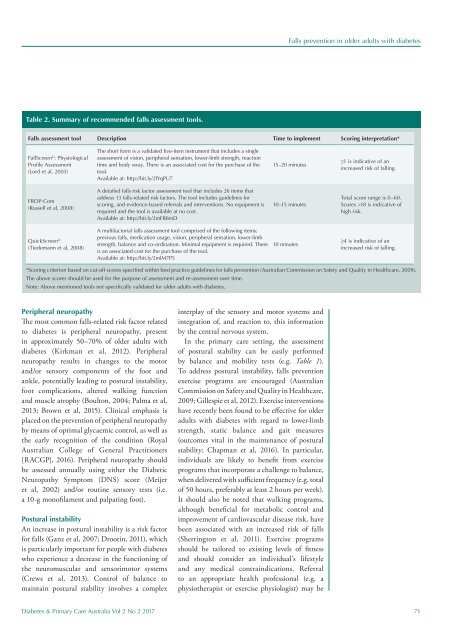DPCA2-2_issue_v3
You also want an ePaper? Increase the reach of your titles
YUMPU automatically turns print PDFs into web optimized ePapers that Google loves.
Falls prevention in older adults with diabetes<br />
Table 2. Summary of recommended falls assessment tools.<br />
Falls assessment tool Description Time to implement Scoring interpretation*<br />
FallScreen © : Physiological<br />
Profile Assessment<br />
(Lord et al, 2003)<br />
The short form is a validated five-item instrument that includes a single<br />
assessment of vision, peripheral sensation, lower-limb strength, reaction<br />
time and body sway. There is an associated cost for the purchase of the<br />
tool.<br />
Available at: http://bit.ly/2lYqPU7<br />
15–20 minutes<br />
≥1 is indicative of an<br />
increased risk of falling.<br />
FROP-Com<br />
(Russell et al, 2008)<br />
A detailed falls risk factor assessment tool that includes 26 items that<br />
address 13 falls-related risk factors. The tool includes guidelines for<br />
scoring, and evidence-based referrals and interventions. No equipment is<br />
required and the tool is available at no cost.<br />
Available at: http://bit.ly/2mFR8mD<br />
10–15 minutes<br />
Total score range is 0–60.<br />
Scores >18 is indicative of<br />
high risk.<br />
QuickScreen ©<br />
(Tiedemann et al, 2008)<br />
A multifactorial falls assessment tool comprised of the following items:<br />
previous falls, medication usage, vision, peripheral sensation, lower-limb<br />
strength, balance and co-ordination. Minimal equipment is required. There<br />
is an associated cost for the purchase of the tool.<br />
Available at: http://bit.ly/2mlM7P5<br />
10 minutes<br />
≥4 is indicative of an<br />
increased risk of falling.<br />
*Scoring criterion based on cut-off scores specified within best practice guidelines for falls prevention (Australian Commission on Safety and Quality in Healthcare, 2009).<br />
The above scores should be used for the purpose of assessment and re-assessment over time.<br />
Note: Above mentioned tools not specifically validated for older adults with diabetes.<br />
Peripheral neuropathy<br />
The most common falls-related risk factor related<br />
to diabetes is peripheral neuropathy, present<br />
in approximately 50–70% of older adults with<br />
diabetes (Kirkman et al, 2012). Peripheral<br />
neuropathy results in changes to the motor<br />
and/or sensory components of the foot and<br />
ankle, potentially leading to postural instability,<br />
foot complications, altered walking function<br />
and muscle atrophy (Boulton, 2004; Palma et al,<br />
2013; Brown et al, 2015). Clinical emphasis is<br />
placed on the prevention of peripheral neuropathy<br />
by means of optimal glycaemic control, as well as<br />
the early recognition of the condition (Royal<br />
Australian College of General Practitioners<br />
[RACGP], 2016). Peripheral neuropathy should<br />
be assessed annually using either the Diabetic<br />
Neuropathy Symptom (DNS) score (Meijer<br />
et al, 2002) and/or routine sensory tests (i.e.<br />
a 10-g monofilament and palpating foot).<br />
Postural instability<br />
An increase in postural instability is a risk factor<br />
for falls (Ganz et al, 2007; Drootin, 2011), which<br />
is particularly important for people with diabetes<br />
who experience a decrease in the functioning of<br />
the neuromuscular and sensorimotor systems<br />
(Crews et al, 2013). Control of balance to<br />
maintain postural stability involves a complex<br />
interplay of the sensory and motor systems and<br />
integration of, and reaction to, this information<br />
by the central nervous system.<br />
In the primary care setting, the assessment<br />
of postural stability can be easily performed<br />
by balance and mobility tests (e.g. Table 1).<br />
To address postural instability, falls prevention<br />
exercise programs are encouraged (Australian<br />
Commission on Safety and Quality in Healthcare,<br />
2009; Gillespie et al, 2012). Exercise interventions<br />
have recently been found to be effective for older<br />
adults with diabetes with regard to lower-limb<br />
strength, static balance and gait measures<br />
(outcomes vital in the maintenance of postural<br />
stability; Chapman et al, 2016). In particular,<br />
individuals are likely to benefit from exercise<br />
programs that incorporate a challenge to balance,<br />
when delivered with sufficient frequency (e.g. total<br />
of 50 hours, preferably at least 2 hours per week).<br />
It should also be noted that walking programs,<br />
although beneficial for metabolic control and<br />
improvement of cardiovascular disease risk, have<br />
been associated with an increased risk of falls<br />
(Sherrington et al, 2011). Exercise programs<br />
should be tailored to existing levels of fitness<br />
and should consider an individual’s lifestyle<br />
and any medical contraindications. Referral<br />
to an appropriate health professional (e.g. a<br />
physiotherapist or exercise physiologist) may be<br />
Diabetes & Primary Care Australia Vol 2 No 2 2017 71
















